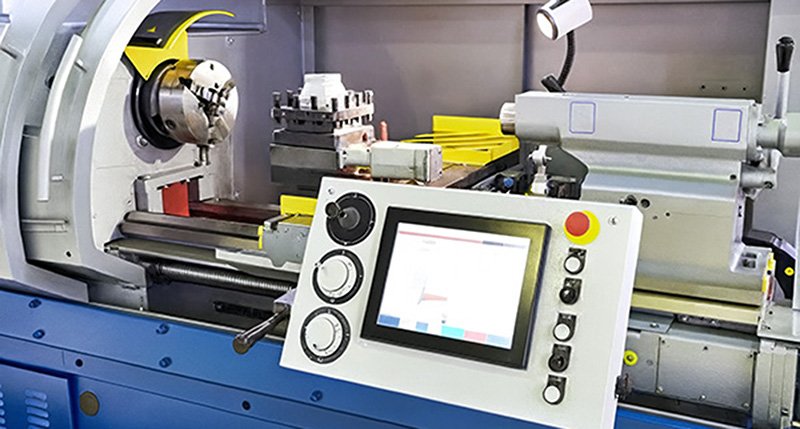A CNC lathe is a type of computer-controlled machine tool designed for turning operations, where a cutting tool removes material from a rotating workpiece to form the desired shape. It is mainly used to machine rotational parts such as shafts, threads, and discs.
CNC lathe is one of the most widely used machines in modern manufacturing. This article provides a comprehensive overview of CNC lathe fundamentals, offering practical insights to help you choose the right equipment for your production needs.
What are the main components of a CNC lathe?
CNC lathes consist of multiple components that work together to achieve part machining. Their main components include:
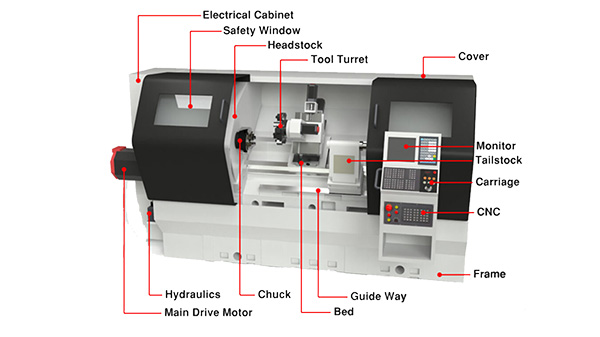
Bed
The bed provides a stable support structure for the entire machine tool, supporting components such as the spindle head and tool holder.
Headstock
The Headstock serves as the core power unit of a lathe, driving the workpiece rotation. It consists of the spindle, bearings, motor, and other components.
CNC System
The CNC system serves as the “brain” of a CNC lathe, responsible for executing machining programs and directing the entire machining process. It primarily consists of a computer, a numerical control unit, and related software. Operators use the computer to write and store machining programs; the numerical control unit decodes these programs and sends control commands to the machine tool’s various motion units.
Feed System
This system primarily controls the axial feed movement of the cutting tool.
Tool Turret
Used for mounting cutting tools and enabling automatic tool switching.
Auxiliary Devices
These primarily include the hydraulic system (for chuck clamping and tailstock thrusting), cooling system, lubrication system, and chip removal devices. Collectively, these devices support the machine tool’s efficient and stable operation.
How Does a CNC Lathe Work?
The typical workflow for a CNC lathe is as follows:
1. Programming
Based on the geometry and machining requirements of the part, engineers write a G-code program that defines all cutting parameters — including tool paths, feed rates, and spindle speeds. This program tells the machine exactly how to shape the workpiece.
2. Program Upload
Upload the completed programme to the CNC system and adjust the relevant parameters.
3. Workpiece installation
The workpiece to be machined is placed on the machine table and fixed securely using appropriate clamping devices.
4. Debugging and Calibration
Before full operation, the operator performs a manual test run to verify that tool paths and work offsets align correctly with the actual workpiece. This step confirms that the coordinate system, zero points, and tool offsets are all set precisely.
5. Machining
After starting the machining program, the cutting tool follows the programmed path to cut the workpiece. Through continuous cutting, the desired contour and dimensions are gradually formed.
6. Monitoring and Adjustments
During machining, the operator needs to observe the cutting status in real time, check tool wear, cutting force changes, and make necessary adjustments to parameters such as cutting speed and coolant flow to ensure stable machining.
7. Completion and Inspection
After the program finishes, the workpiece is removed from the machine. The operator cleans the workspace and performs an initial quality inspection to verify that dimensions and surface accuracy meet the design specifications.
What operations can be performed on a CNC lathe?
Turning is a versatile machining process used to manufacture components across most industries. Numerous turning operations exist, including threading, boring, face machining, turning, drilling, and tapping .For more details, please refer to our other article.
What Are the Types of CNC Lathes?
There exists a wide variety of lathes, which can be systematically categorised according to different criteria:
According to the degree of automation and processing capacity
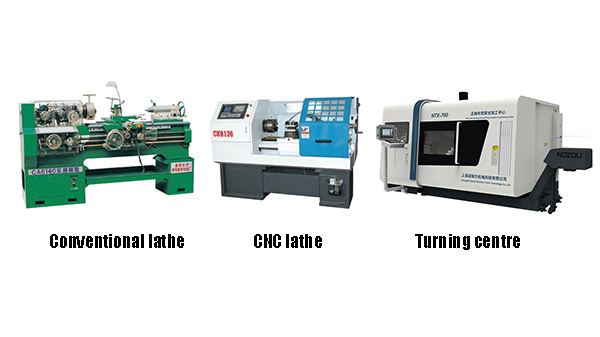
Conventional lathe: Mainly relies on the operator to manually control the cutting tool for machining.
CNC lathe: Controlled by the CNC system to move the cutting tool and automatically execute the machining program.
Turning centre: A turning center is a more advanced type of CNC lathe. In addition to the functions of a regular CNC lathe, it is equipped with an automatic tool changer, capable of performing milling, turning, drilling, and other compound machining operations.
According to the spindle layout configuration
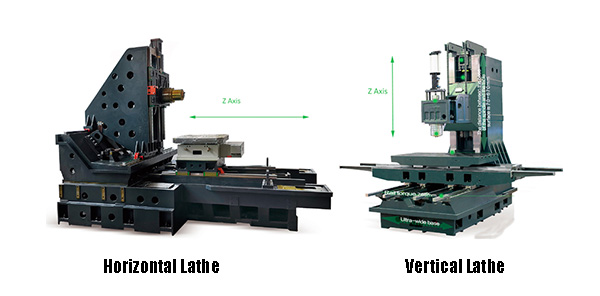
Horizontal Lathe: The spindle is arranged horizontally, with the workpiece clamped between the headstock and the tailstock. It is suitable for machining long and slender shaft-type parts.
Vertical Lathe: The spindle is arranged vertically and equipped with a large horizontal worktable for mounting the workpiece.This structure utilizes the table’s load-bearing capacity, making it ideal for machining large-weight, large-dimension discs, wheels, and cover-type components.
According to the processing principle and structural level
Saddle-Type CNC Lathe: This is the standard configuration for most CNC lathes. The workpiece rotates inside the spindle, while the tool post moves to perform cutting operations. It is suitable for machining medium-length, relatively simple shaft- or disc-type parts.
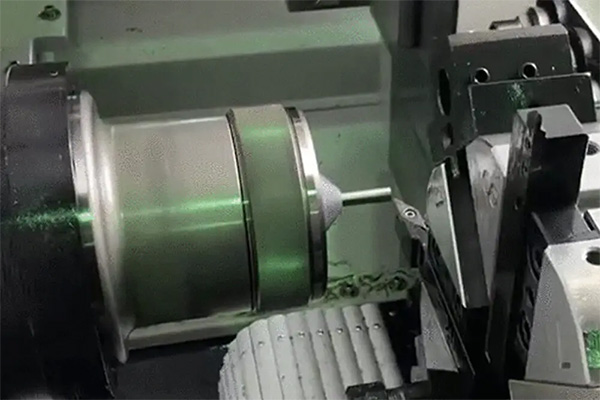
Swiss-Type CNC Lathe: The key feature of a Swiss-type lathe is that the headstock drives the workpiece and bar stock to move along the Z-axis, while the cutting tools surround and machine the workpiece. This design provides excellent support and stability, making it ideal for machining long and slender shaft-type parts.
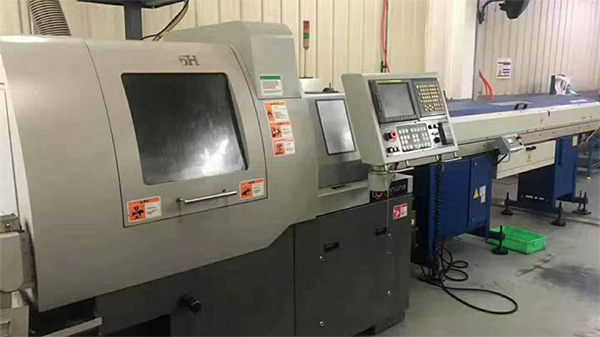
Single-turret CNC lathe: This is the most common lathe configuration, featuring a single turret capable of mounting 4 to 12 tools. During machining, the required tool is selected by rotating the turret.
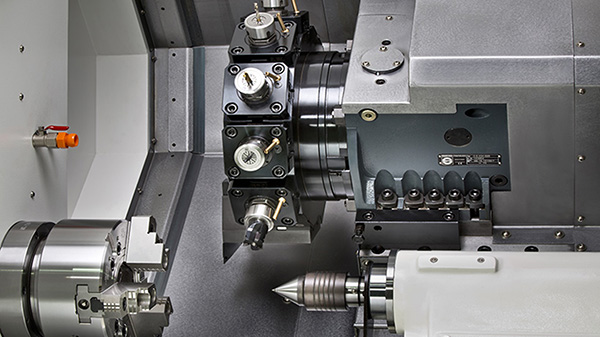
Double-turret CNC lathe: Equipped with two independent turrets, both turrets can simultaneously perform machining operations on different sections of a single workpiece, or process two separate workpieces concurrently. This configuration offers higher efficiency than single-turret CNC lathes.
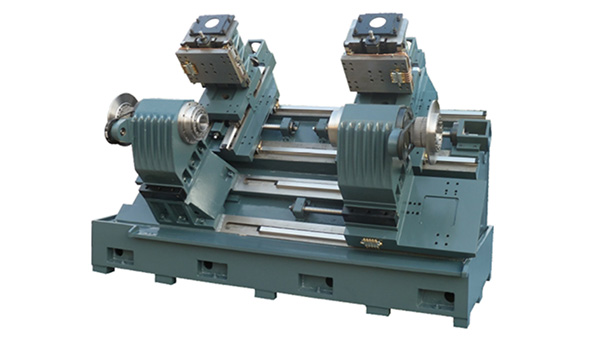
How much does a CNC lathe cost?
The price of a CNC lathe is primarily determined by its machining capabilities, level of automation, and brand. Prices generally start from $3,000 USD, while high-end multi-tasking machines can exceed $200,000 USD.
CNC Lathe Manufacturers Worth Considering
If you have very high demands for precision and reliability and a sufficient budget, consider top European brands such as Reiden, Willemin-Macodel, HAMUEL, Alzmetall, and CHIRON. These manufacturers represent the highest level of European machining centers, with individual machines typically priced between USD 200,000 and 800,000 or more.
If you are looking for exceptional accuracy and long-term stability, brands such as Okuma, DMG MORI, Makino, and Toyoda are among the world’s leading mid-to-high-end machine tool manufacturers. Their machines are well known for precision, reliability, and performance, usually priced in the range of USD 80,000 to 150,000.
If your goal is to balance performance and cost, consider brands such as Mazak, HAAS, and Tongtai. These machines are robust, durable, and stable, making them an excellent choice for maintaining product quality and production efficiency. Prices typically range from USD 60,000 to 110,000.
Of course, there are many other CNC lathe brands available in the market. Prices vary depending on the machine structure, control system, machining accuracy, and level of automation.
Before purchasing a CNC lathe, it is recommended to evaluate comprehensively based on part type, production volume, required precision, and operator skill level. Choosing the right model and configuration will help you achieve the best balance between performance and cost.
Conclusion
As a powerful core manufacturing tool, the CNC lathe can efficiently handle a wide range of precision machining tasks. Its value lies not only in improving accuracy, efficiency, and consistency through automation but also in its deep alignment with specific production needs.
Therefore, when selecting equipment, a comprehensive assessment of its performance should be undertaken to ensure that this investment translates into a lasting competitive advantage.
Xmake provides professional CNC turning services, equipped with multiple advanced CNC lathes capable of machining various parts. Feel free to contact us anytime for part machining.

